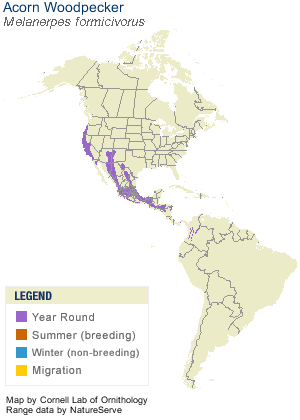Acorn Woodpecker
Clarabelle

About Clarabelle
We are sad to announce the passing of Clarabelle on Saturday, Sept 16, 2023.
Clarabelle came to us in 2007 from Stanislaus Wildlife Care Center. She, unfortunately, was unable to be returned to her colony in the allotted time period of 2 weeks due to no one knowing where her exact home was-- failure to return an acorn woodpecker in 2 weeks to their colony results in the bird being rejected by its colony with the eventual outcome being death by starvation.
She joined our ambassador team and through her many antics, taught our community how precocious and personality filled acorn woodpeckers are. Clarabelle lived to the age of 17, which according to google, is on track with one of the longest lived acorn woodpeckers recorded.

Acorn Woodpecker Facts
Melanerpes formicivorus - Acorn Woodpecker
Food and Eating Habits: Look for an oak tree or a telephone pole or even the side of a wood building. pocked with thousands of small holes and stuffed tightly with acorns. Called a granary, this cache serves as an emergency pantry. They also feed on ants (its Latin name means "ant-eater"), beetles, flying insects, and wild fruit.
Anatomy: All woodpeckers have a skull that is thick and shock-absorbing, which allows them to withstand their constant hammering. The base of their tongue wraps around the skull, anchoring behind the nostrils, and extends far enough to reach deep into wood-bores to catch a grub. A woodpecker's feet are zygodactyl, which means two toes forward and two toes backward, and are ideally adapted to climbing trees. Their stiff tail props them upright while they climb the tree and drill holes.
Behavior: The species is unique in that it's a very close familial and communal bird, sharing nesting and rearing duties with the up to 15 members within its colony. It's a complex society, divided between the breeders and "helpers", which are usually the group's offspring. They are very territorial and status-conscious, normally tolerating only other members of their group. When an Acorn Woodpecker is found injured or orphaned, it is extremely important to the rehabilitator that the bird is returned within two weeks to the exact colony from which it came, since its place in the commune will be filled by another woodpecker. Any later than two weeks and the displaced bird will be rejected and chased away from the food source, and will starve to death.
Length: 9" Wingspan: 17" Weight: 2.8 oz (80 gm)
Life span in the wild: Approximately:12 years
Range: Non-migratory, ranges from Oregon and California south to Colombia
Difference between sexes:
Male faces don't have a black bar between the white over beak and the red cap.
